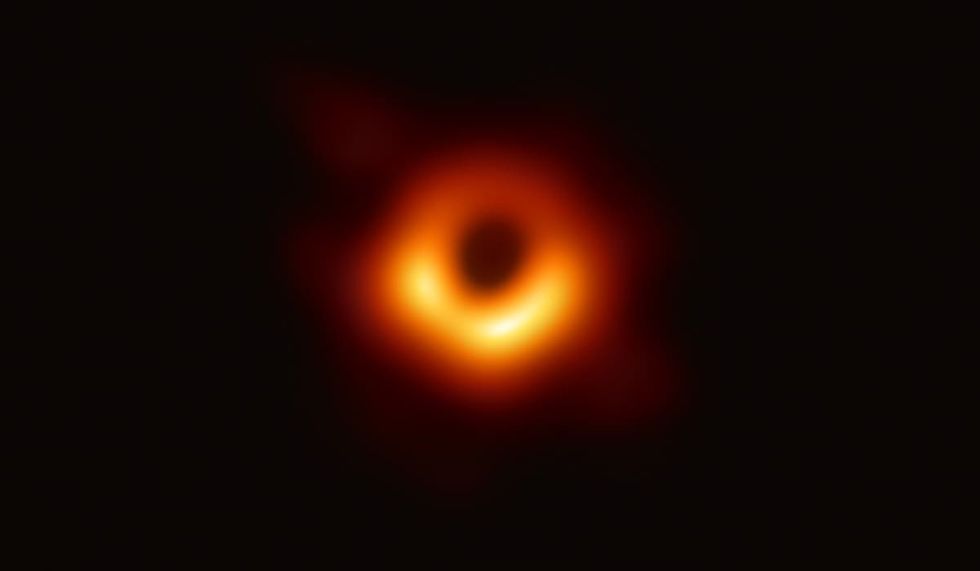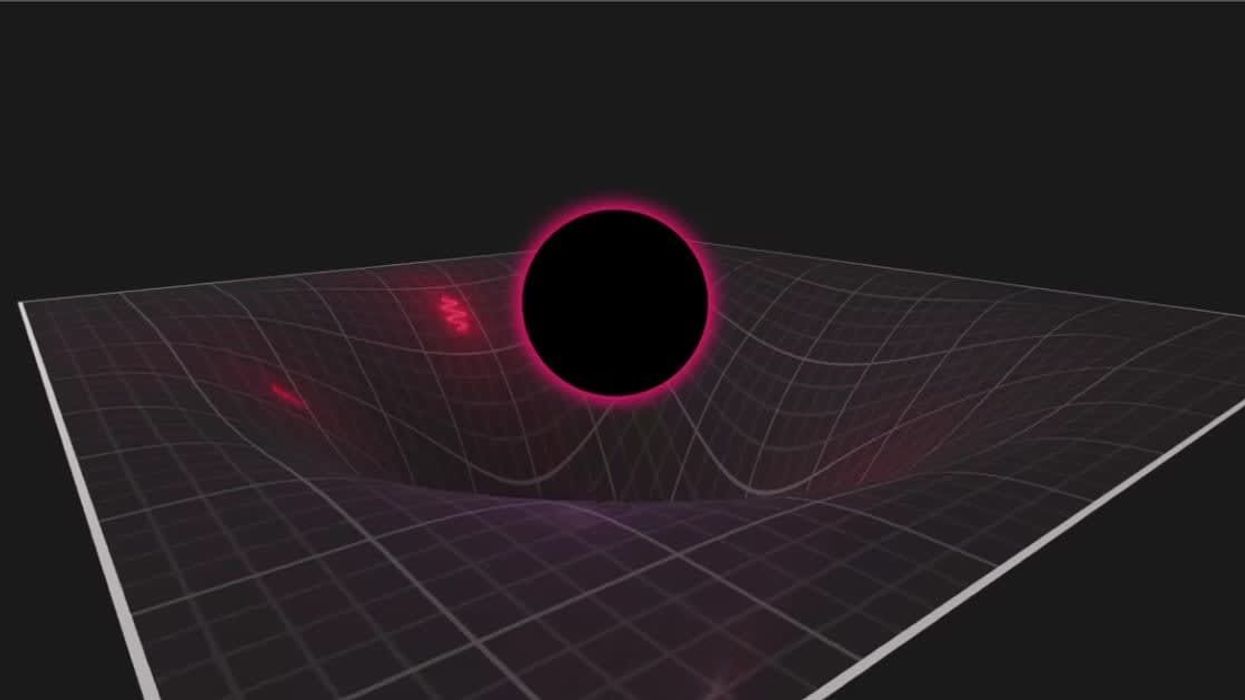Black holes are the most mysterious cosmic objects that NASA has ever studied. The most intriguing thing about a black hole is that gravity and spacetime are so strong in it that even light can't escape. Recently, scientists have created simulated black holes to help their understanding of the phenomenon. The black hole analog replicates the theoretical radiation emitted by the real thing, as per Science Alert and can help scientists study the black hole in actual detail.

These scientists have used a chain of atoms in a single file to simulate the event horizon of a black hole and experienced what is known as the "Hawking radiation." The phenomenon can be described as particles born from disturbances in the quantum fluctuations caused by the black hole's break in spacetime.
The researchers believe that the simulation can help resolve the friction between two conflicting frameworks that describe the universe i.e. the general theory of relativity and quantum mechanics. The general theory of relativity, also known as Einstein's theory of relativity, describes the behavior of gravity as a continuous field known as spacetime. Quantum mechanics describes the behavior of particles using the mathematics of probability.
For a unified theory of quantum gravity that can be applied universally the relation between these two theories needs to be found first. Black holes may be the answer to the question. At a certain distance from the black hole's center, even the speed of light can't escape due to the incredible density. This distance that varies based on the mass of the black hole's center is known as the event horizon. What happens when something enters a black hole's event horizon is unknown. However, in 1974, Stephen Hawking said that the interruptions to quantum fluctuations caused by the event horizon of a black hole are quite similar to thermal radiation.
As per Hawking radiation, if a black hole loses more mass than it gains, it will eventually vanish. It is the theoretical black hole radiation that states that a smaller black hole is hotter than a larger one. The Hawking radiation, even if it exists, is too faint to be detected. However, the theoretically made black hole analogs can help us learn some things about the behavior of a black hole in a laboratory. Several simulations have been created before, but now one led by Lotte Mertens from the University of Amsterdam in the Netherlands has done something different.
They tried to analyze the properties of Hawking radiation and were quite surprised when the black hole analog started to glow. Hawking radiation is an odd phenomenon as it causes the black hole to glow while the event horizon of a black hole is supposed to be an area from which even light cannot escape. The team also observed that the glow or the Hawking radiation occurred only when a part of the chain extended beyond the event horizon. This shows that an entanglement of particles in the event horizon is necessary to create the radiation. "This can open a venue for exploring fundamental quantum-mechanical aspects alongside gravity and curved spacetimes in various condensed matter settings," the researchers wrote in the Physical Review Research.
This article originally appeared 7 months ago.

















 Pexels | Photo by Andrea Piacquadio
Pexels | Photo by Andrea Piacquadio
 An Atlantic grey seal looking at the camera underwater. (Representative Image Source: Getty Images | Mark Chivers)
An Atlantic grey seal looking at the camera underwater. (Representative Image Source: Getty Images | Mark Chivers) A grey seal swims up to a scuba diver. (Representative Image Source: Getty Images | Huw Thomas)
A grey seal swims up to a scuba diver. (Representative Image Source: Getty Images | Huw Thomas) A Grey seal nibbles at the hood of a scuba diver. (Representative Image Source: Getty Images | Bernard Radvaner)
A Grey seal nibbles at the hood of a scuba diver. (Representative Image Source: Getty Images | Bernard Radvaner)
 Image Source: Seth Rogen and Lauren Miller Rogen co-host the HFC Austin Brain Health Dinner on September 30, 2023, in Austin, Texas. (Photo by Rick Kern/Getty Images for Hilarity for Charity)
Image Source: Seth Rogen and Lauren Miller Rogen co-host the HFC Austin Brain Health Dinner on September 30, 2023, in Austin, Texas. (Photo by Rick Kern/Getty Images for Hilarity for Charity) Image Source: Seth Rogen and Lauren Miller Rogen attend the 95th Annual Academy Awards on March 12, 2023 in Hollywood, California. (Photo by Arturo Holmes/Getty Images )
Image Source: Seth Rogen and Lauren Miller Rogen attend the 95th Annual Academy Awards on March 12, 2023 in Hollywood, California. (Photo by Arturo Holmes/Getty Images ) Image Source: YouTube |
Image Source: YouTube |  Image Source: YouTube |
Image Source: YouTube | 
 Representational Image Source: Pexels I Photo by Nataliya Vaitkevich
Representational Image Source: Pexels I Photo by Nataliya Vaitkevich Representative Image Source: Pexels | Kampus Production
Representative Image Source: Pexels | Kampus Production
 Image Source: Destroyed vehicles lie near the rubble after the earthquake and tsunami devastated the area on March 16, 2011, in Minamisanriku, Japan. The 9.0 magnitude strong earthquake struck offshore on March 11 at 2:46 pm local time, triggering a tsunami wave of up to ten meters which engulfed large parts of north-eastern Japan. (Photo by Chris McGrath/Getty Images)
Image Source: Destroyed vehicles lie near the rubble after the earthquake and tsunami devastated the area on March 16, 2011, in Minamisanriku, Japan. The 9.0 magnitude strong earthquake struck offshore on March 11 at 2:46 pm local time, triggering a tsunami wave of up to ten meters which engulfed large parts of north-eastern Japan. (Photo by Chris McGrath/Getty Images) Representative Image Source: Pexels | Pixabay
Representative Image Source: Pexels | Pixabay Representative Image Source: Pexels | Stuart Pritchards
Representative Image Source: Pexels | Stuart Pritchards
 Image Source: Musician Keith Urban and actress Nicole Kidman arrive at the 2009 American Music Awards at Nokia Theatre L.A. Live on November 22, 2009 in Los Angeles, California. (Photo by Jeffrey Mayer/WireImage)
Image Source: Musician Keith Urban and actress Nicole Kidman arrive at the 2009 American Music Awards at Nokia Theatre L.A. Live on November 22, 2009 in Los Angeles, California. (Photo by Jeffrey Mayer/WireImage) Image Source: Keith Urban and Nicole Kidman attend The 2024 Met Gala on May 06, 2024 in New York City. (Photo by John Shearer/WireImage)
Image Source: Keith Urban and Nicole Kidman attend The 2024 Met Gala on May 06, 2024 in New York City. (Photo by John Shearer/WireImage) Image Source: Musician Keith Urban and actress Nicole Kidman arrive at the Oscars on February 24, 2013 in Hollywood, California. (Photo by Jeff Vespa/WireImage)
Image Source: Musician Keith Urban and actress Nicole Kidman arrive at the Oscars on February 24, 2013 in Hollywood, California. (Photo by Jeff Vespa/WireImage)
 Representative Image Source: Pexels | August de Richelieu
Representative Image Source: Pexels | August de Richelieu Representative Image Source: Pexels | August de Richelieu
Representative Image Source: Pexels | August de Richelieu Representative Image Source: Pexels | Djordje Vezilic
Representative Image Source: Pexels | Djordje Vezilic Representative Image Source: Pexels | Fauxels
Representative Image Source: Pexels | Fauxels
 Mount tai top gate (Representative Image Source: Getty Images | www.anotherdayatoffice.org)
Mount tai top gate (Representative Image Source: Getty Images | www.anotherdayatoffice.org) These ancient Chinese Buildings have been here on the side of Mt Tai the Holy mountain for decades and visited by thousands. One of most holy locations in China (Representative Image Source: Getty Images | jmoor7)
These ancient Chinese Buildings have been here on the side of Mt Tai the Holy mountain for decades and visited by thousands. One of most holy locations in China (Representative Image Source: Getty Images | jmoor7) Mount Tai (Mt Taishan) is one of the most famous mountain in China, it is also a UNESCO World Heritage Site. (Representative Image Source: Getty Images | DNeutral Han)
Mount Tai (Mt Taishan) is one of the most famous mountain in China, it is also a UNESCO World Heritage Site. (Representative Image Source: Getty Images | DNeutral Han) A comment about the challenging journey by
A comment about the challenging journey by